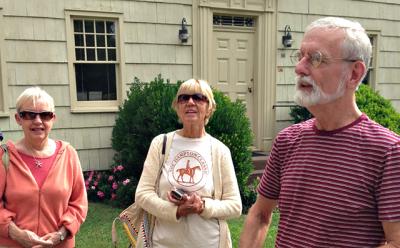Historical Society Director to Step Down

The news that Richard Barons, executive director of the East Hampton Historical Society since 2006, will retire in the spring spread consternation through museum and collectors’ circles last week. Mr. Barons, who has been on vacation in Paris with his wife, Roseanne, informed the society’s board of his decision on Oct. 17.
Robert Hefner, who as East Hampton Village’s historic preservation consultant has hardly gone a day without seeing or speaking with Mr. Barons, said his leaving would be “a great loss — tremendous.”
“In my mind, the historical society has never had anyone of Richard’s caliber except Dean Failey, who was here for a very short time and went to Christie’s when that opportunity came up,” said Mr. Hefner. “My work here changed dramatically when Richard arrived. I had somebody to work with. The two of us — it has been a great partnership. My focus is on buildings; he has museum experience. A number of projects depend greatly on him.”
He cited the ongoing restoration of the Thomas Moran house and studio on Main Street, a National Historic Landmark; the Dominy woodworking and clockmaker’s shops, which await a move back to their original sites on North Main Street; the recently acquired Gardiner Mill cottage on James Lane, which will play a key part in the historical society’s educational programming, and the Rattray-Hedges barn, which is soon to cross Main Street on its way to the society’s Mulford Farm property.
“They are all destined to become museums,” Mr. Hefner said. “None of that will be finished when he leaves. The Dominy shops won’t even be started. He was the perfect person to see these into fruition. I would say he’s irreplaceable.”
Mr. Barons “is irreplaceable,” echoed Maureen Bluedorn, a board member of both the Moran Trust and the historical society, “in the sense of his knowledge and enthusiasm and way of being able to craft programs of interest. The Musketeer Days, the children’s programs, the events at Mulford Farm, the things that brought people to the historical society — not just houses standing there. He brought an effervescence to the society and to the town.”
“Richard Barons came here in 1999 and changed the Southampton Historical Museum,” said Tom Edmonds, Mr. Barons’s opposite number at the Southampton Historical Society. “He brought it into the 20th century before it went into the 21st. He introduced classroom visits from schools, he rearranged the exhibits so it wasn’t a grand medley of everything we had, he oriented the Rogers Mansion [home of the museum] into the merchant’s house it was supposed to be. Before Richard, it was a cabinet of curiosities.”
“He was a great lecturer. Can I even say, ‘entertainer?’ He made history so interesting,” Mr. Edmonds said. “He inspired the board to do more than they were used to doing.”
Hugh King, East Hampton Village’s historian and town crier, was initially reluctant to talk about Mr. Barons’s departure, not having heard it from the horse’s mouth and, he admitted, hoping against hope that it might not be so. After Mr. Barons confirmed it in an email to The Star from France, however, Mr. King said, “I don’t know how we are going to find one person to do what Richard did.”
“We will lose not only the accurate memory of the past, but part of our conscience of how to do things correctly,” he said.
Scuttlebutt has it that the Baronses will move to Cape Cod. “The call of the sea is very strong for him,” Mr. Edmonds said. “He needs to be in New England by the sea. I think it will be hard for him to leave here, though.”
Mr. Barons’s decision to retire, though not entirely unexpected, was “not a welcome surprise,” said Arthur (Tiger) Graham, president of the board of directors of both the historical society and the Moran Trust.
“He’s been a superb director. We love him to death. We’d hoped he’d want to do it forever,” said Mr. Graham. “But he’s reaching a milestone birthday.” Mr. Barons will be 70 next year.
A search committee has been formed and a new executive director is expected to be named in April. Mr. Barons, who plans to leave in mid-May, has suggested several museum publications for the committee to advertise in.
Mr. King, like others, mentioned the cost of housing here and wondered where the new director would live, assuming he or she comes from away.
“We’re not looking to get a big-time museum person, but someone who will fit our needs and we will fit their skill set,” Mr. Graham said.
“A couple of local people,” he said, have expressed interest.
